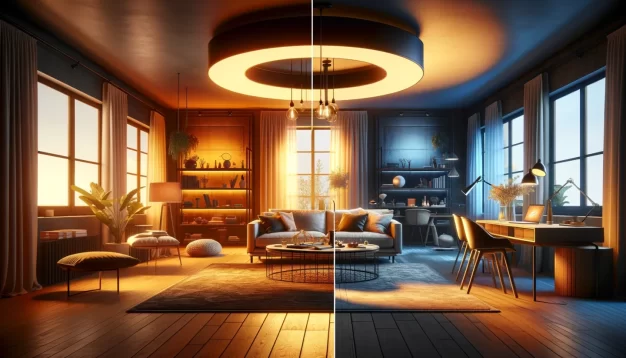Using Color in Lighting
Master the mood of any room with our guide on ideal color lighting choices.

Introduction to Color Lighting in Photography
Color lighting is pivotal in photography, affecting mood, narrative, and visual aesthetics. A photographer’s grasp of color and its application can elevate their work from mundane to extraordinary.
Understanding Color Theory
The color wheel and color harmony are foundational concepts in color theory, delineating relationships between hues. Complementary colors, which are opposite each other on the wheel, create vibrant contrasts, while analogous colors, which sit side by side, offer harmony.
Importance of Color in Composition
Color can direct the viewer’s eye and impart emotional resonance. For instance, warm colors often evoke feelings of comfort, while cool tones can induce calmness or detachment.
Types of Color Lighting
Natural vs. Artificial Lighting
Natural light, with its varying qualities throughout the day, offers a range of hues and intensities. Artificial lighting, controlled and manipulable, includes continuous lights, strobes, and flashes.
Color Temperature Basics
Measured in Kelvin, color temperature affects the warmth or coolness of an image. Low Kelvin numbers yield warmer, yellowish colors, while higher numbers produce cooler, bluish tones.
Equipment for Color Lighting
Gels and Filters
Gels change light color, creating effects or correcting color temperature. Filters can be applied to lenses for similar purposes.
LED Panels and Colored Bulbs
LED panels offer adjustable hues and intensities. Colored bulbs are simpler, less versatile color lighting solutions.
Techniques for Color Lighting
Mixing Light Colors
Combining different light colors requires finesse. Incorrect blends can result in muddy or unintended colors.
Creating Mood with Colors
Colors provoke emotions; for instance, red may signal danger or passion, while blue might suggest serenity.
Using Color for Storytelling
Colors tell stories. A single hue shift can alter a scene’s narrative context significantly.
Challenges and Solutions
White Balance Adjustments
Accurate white balance ensures colors are true to life. Cameras sometimes struggle with this, necessitating manual adjustments.
Dealing with Mixed Lighting
Mixed lighting is tricky—light sources with different color temperatures can wreak havoc on a scene. Diligent scene analysis and corrective measures are vital.
Post-Processing Color Lighting
Color Grading in Editing Software
Color grading adjusts the mood and tone of images in post-production. Tools like Adobe Lightroom and Photoshop are industry standards.
Balancing Colors for Cohesion
Post-processing should aim for color consistency across an image or series, ensuring visual cohesion.
Conclusion and Further Resources
Recap of Key Takeaways
Color lighting in photography is a complex yet rewarding area. It requires an understanding of color theory, the right equipment, and the skill to handle various lighting situations and post-processing techniques.
Books and Tutorials for Advanced Learning
To delve deeper, seek out comprehensive texts like "Color and Light: A Guide for the Realist Painter" by James Gurney, or online tutorials from platforms like CreativeLive or Lynda.com.
In the realm of photography, mastering color lighting is akin to a painter mastering their palette—a blend of art and science that, when harnessed correctly, can create masterpieces.